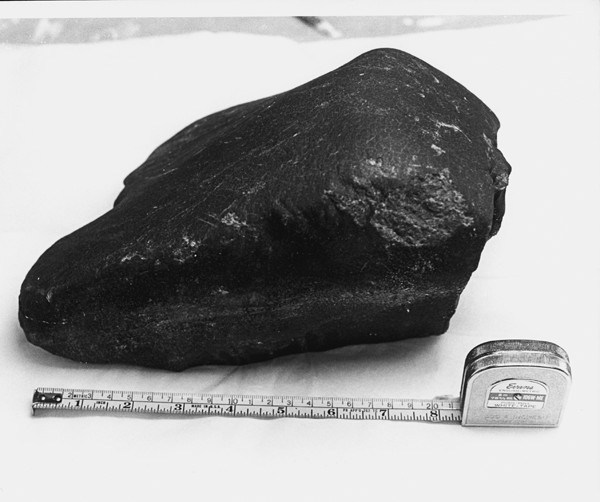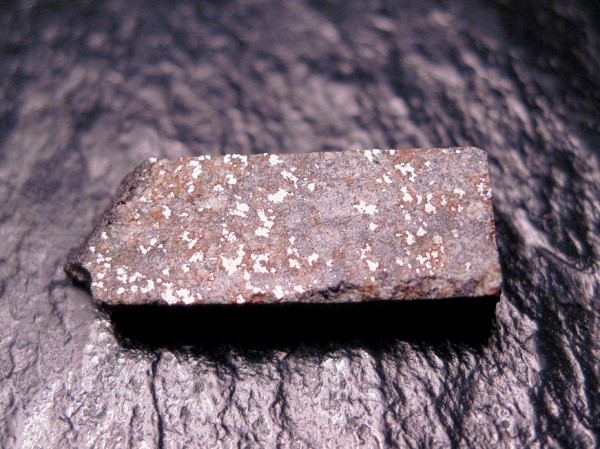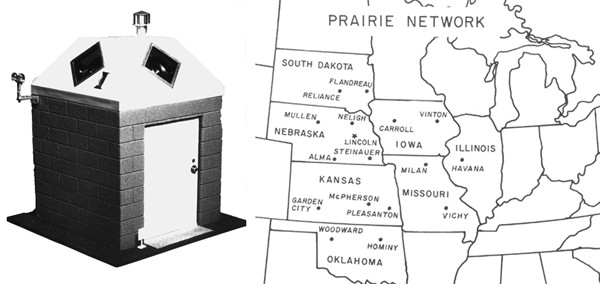
by Sara E. Pratt Monday, December 8, 2014

More than 17 kilograms of fragments of the Lost City meteorite were found. The largest, shown here, weighed 9.83 kilograms. Credit: SAO courtesy of APDA/PARI.
On the evening of Saturday, Jan. 3, 1970, residents of northeastern Oklahoma saw a fireball as bright as a full moon blaze across the sky. The nine-second light display was accompanied by a sonic boom heard over a 1,000-square-kilometer area.
They were not the only ones observing the sky that night. The streak was also seen and photographed by four of the 16 cameras of the Smithsonian Astrophysical Observatory’s (SAO) Meteorite Photography and Recovery Project, also known as the Prairie Network. The project had been founded in 1962 to track extremely bright meteors and aid attempts to recover newly fallen meteorites.
Within four days of the Oklahoma meteor streaking through the sky, calculations based on its trajectory — captured in the photographs — had allowed researchers to delineate a possible landing zone: an area near Lost City, Okla., in the foothills of the Ozarks about 70 kilometers east of Tulsa. Two days after that, Gunther “Skip” Schwartz, a field manager for the Prairie Network in Lincoln, Neb., arrived in Lost City to find that 20 centimeters of snow had fallen since the fireball had been observed.
That afternoon, Schwartz was driving down a hard-packed dirt road east of town when he spotted a dark object lying in the road in front of him. Just 800 meters from the predicted impact site, Schwartz found a 9.83-kilogram chunk of rock from outer space. “I suddenly saw it in the road,” he later told a reporter from the Des Moines (Iowa) Register. “I was hysterical. I couldn’t believe my luck.” His only regret, he added, was that he was alone and had no one with whom to share his euphoria over the fortuitous find.
The Lost City meteorite, as it would come to be known — in all, four fragments totaling 17 kilograms — was the first and only meteorite recovered by the Prairie Network.
By comparing the moving fireball with the stellar background in the Prairie Network photographs, researchers calculated its speed and direction. In the time that the meteor’s trail was captured on film, it slowed from 14.2 kilometers per second to 3.5 kilometers per second and dropped from an altitude of 86 kilometers to 19 kilometers.
During the descent, several streaks were observed branching off the main trail, indicating the meteor had fragmented. During the last 1.5 seconds of the trail, three separate fragments, with fainter trails, are visible on the film. Richard McCroskey, director of the Prairie Network, and his team used these data to estimate the landing sites of other fragments as well.
A little more than a week after the main fragment was found, a second fragment, weighing 272 grams, was discovered in a pasture by a local farmer, Philip Halpain.
A third fragment, weighing 6.6 kilograms, was discovered by the SAO search team on Feb. 2 after they spoke to Rufus Yaeger, a local resident who had stepped out onto his porch just as the fireball descended out of camera range and before the sonic boom arrived. He reported seeing three red lights in the sky, which he thought was an aircraft in distress. A few seconds later, he said, he heard “a thud, like something heavy hitting the ground,” and was able to point the searchers in the right direction.
A fourth fragment, weighing 640 grams, was found on May 4 by a local resident who was with Schwartz and another member of the search team at the time.
Three of the four fragments easily fit together like puzzle pieces, indicating that they originated from a single body, but with tantalizing gaps suggesting some pieces may remain missing. “Other fragments were certainly produced at the time of the disruption that produced the three pieces,” wrote Roy Clarke, curator of meteorites at the Smithsonian National Museum of Natural History, in a 1971 Geophysical Research Letters article. “It is possible that large fragments remain to be recovered.”
The search for remaining fragments was called off on Dec. 6, 1970, after 600 hours of ground searching, covering 3.4 square kilometers. Today, two of the four fragments are in the Smithsonian collections. The other two fragments are in private hands, but were lent to scientists for nondestructive testing shortly after their discovery — which proved to be a boon to meteorite researchers.

A one-gram slice, showing a fused edge, of the chondritic Lost City meteorite. Credit: ©Jon Taylor, CC-BY-SA-2.0.
In the mid-20th century, the burgeoning Space Race, the launch of Sputnik, the establishment of NASA and the application of advances in nuclear physics to the field of meteoritics drove the need for more material from outer space for scientists to study. Different ideas about how to get that material led to a decade-long power struggle between the Smithsonian National Museum in Washington, D.C., and the SAO in Cambridge, Mass., which had risen to scientific prominence in the late 1950s by developing methods to track artificial satellites.
Throughout the 1960s, the two groups skirmished over who would be responsible for searching for meteorites, negotiating their purchase from collectors, distributing samples for study, and storing, preserving and curating them for posterity.
In 1960, Edward Henderson, curator of meteorites at the National Museum, requested a modest $30,000 to fund ground searches after reports of meteor sightings. SAO director Fred Whipple had a much more ambitious plan. He wrote a $300,000 proposal for a network of cameras spread around the Midwest to capture the descents of bright meteors on film. The Midwest was chosen because the vast, flat, accessible and relatively rock-free terrain would improve chances of recovering any meteorites that hit the ground. Scientists could then use the imagery to calculate a trajectory, narrow the predicted landing zone and conduct a targeted search to try to recover a newly fallen meteorite.
Both proposals were ultimately funded and garnered support from different factions in the astrophysics community. Tensions were exacerbated in July 1960 when the office of the secretary of the Smithsonian issued a press release titled “Science Needs More Fallen Stars,” which announced that a new program to collect meteorites across the country and distribute them to scientists for study would be based at SAO.
Distribution of samples to scientists for study had long been the responsibility of the National Museum, and Henderson stepped up his campaign for the museum to take the lead role, enlisting the support of a cadre of famous scientists and soliciting more funding. His efforts paid off. In 1963, the museum’s newly formed division of meteorites received a large grant from NASA to buy new equipment, including an electron microprobe, and to hire more research staff and fund the purchase of meteorites from collectors.
The rivalry between the museum and the SAO’s Prairie Network came to an amicable end with the discovery of the Lost City meteorite in 1970, when scientists from both groups came together to locate, recover and distribute samples for study.

A typical camera housing located at each of the 16 sites of the Smithsonian Astrophysical Observatory's Prairie Network. The Lost City fireball was captured by cameras in Hominy and Woodward, Okla., and Pleasanton and Garden City, Kan. Credit: SAO courtesy of APDA/PARI.
Within hours of Schwartz’s discovery of the 9.83-kilogram specimen on the dirt road, he and the meteorite were on an overnight flight to Washington, D.C. Arriving in the wee hours of Jan. 10, his plane was met by McCroskey, Clarke and a NASA scientist. “It was 4 a.m. when the four of us excitedly unwrapped the rock at the plane’s arrival gate, to the mystification of the sleepily deplaning passengers,” McCroskey wrote in Sky & Telescope in 1970.
Later that morning, technicians at the Smithsonian began photographing the meteorite, making plastic molds (some weighted with lead) and cutting samples, which were quickly distributed to researchers across the country. The meteorite was identified as an ordinary H5 chondrite, a type of meteorite containing high levels of iron and small chondrules that has been metamorphosed under temperature conditions sufficient to “homogenize olivine and pyroxene, convert all low-calcium pyroxene to orthopyroxene, cause the growth of various secondary minerals, and blur chondrule outlines,” according to Meteoritical Society classification guidelines.
The rapid recovery of the meteorite allowed scientists to make a quick analysis of short-lived radioactive isotopes from cosmic rays, which provided new clues to researchers studying the early formation of the solar system.
The photographs of the Lost City fireball also allowed astronomers to calculate not only the meteor’s trajectory, but also its orbit. At a time when the connection between asteroids and meteorites was still being debated, researchers traced the meteor’s origins back to the asteroid belt between Mars and Jupiter.
However, one type of data that the Lost City meteorite was unable to provide was evidence of organic material. Despite Schwartz’s astounding good fortune to happen upon the meteorite just days after it fell, someone else got there first.
“Judging from the footprints around the meteorite and the stained snow immediately adjacent to it,” McCroskey’s team wrote in a 1971 article in Geophysical Research Letters, “we believe this object to have been seriously contaminated by a dog or some other canine.”
In another article in the same issue of the journal, Clarke and colleagues flatly noted that “studies of organic matter in this meteorite are not currently of great interest” due to “the probability of a canine’s contribution of terrestrial biological substances to the 9.8-kilogram specimen.”
© 2008-2021. All rights reserved. Any copying, redistribution or retransmission of any of the contents of this service without the expressed written permission of the American Geosciences Institute is expressly prohibited. Click here for all copyright requests.